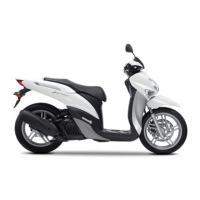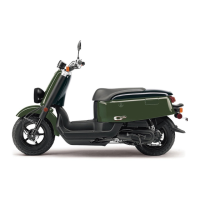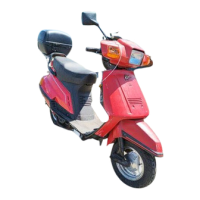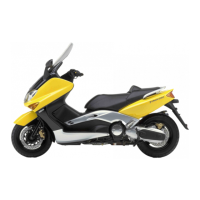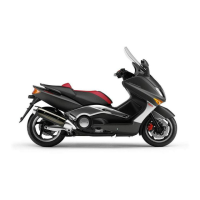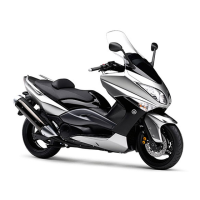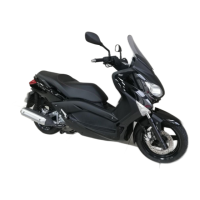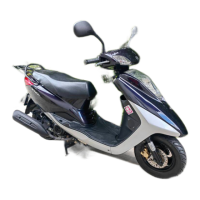Do you have a question about the Yamaha xenter HW125 and is the answer not in the manual?
Owner's responsibilities for safe and proper operation, including training and maintenance.
Pre-operation checks, rider posture, and general safe riding practices.
Essential protective gear recommendations for rider safety, including helmets, jackets, and gloves.
Hazards of carbon monoxide from exhaust and precautions to avoid poisoning.
Guidelines for adding cargo or accessories to maintain scooter stability and handling.
Information and recommendations for using genuine Yamaha accessories.
Safety considerations for aftermarket parts and modifications.
Instructions for safely transporting the scooter in another vehicle.
Additional tips for safe riding, including signaling, braking, and road hazards.
Identifies key components on the left side of the scooter.
Identifies key components on the right side of the scooter.
Details the location and function of various controls and instruments.
Operation and positions of the main switch and steering lock.
Step-by-step instructions for locking the scooter's steering.
Explanation of dashboard indicator and warning lights.
Overview and components of the multi-function display.
Using and resetting odometer, fuel, and tripmeters.
Oil change and V-belt replacement indicators and tripmeters.
Setting the clock and checking the fuel meter.
Function and location of handlebar switches.
Operation of front and rear brake levers.
Procedure for opening and closing the fuel tank cap.
Safety instructions for refueling gasoline.
Fuel type, capacity, and catalytic converter heat precautions.
Instructions for opening and closing the scooter seat.
Operation of passenger footrest and front storage compartment.
Safety precautions for handling the shock absorber assembly.
Load limits and usage for carrier and luggage holder.
Checks for fuel, oil, coolant, and control cables.
Checks for front/rear brakes, throttle grip, and cables.
Checks for wheels, tires, levers, centerstand, and fasteners.
Checks operation of instruments, lights, signals, and switches.
Step-by-step guide for starting the engine, including pre-checks.
Procedures for starting to ride and proper braking techniques.
Tips for fuel economy and engine break-in procedures.
Safety considerations for parking the scooter, including heat and fire hazards.
Location and purpose of the owner's tool kit.
Schedule for maintenance tasks related to the emission control system.
Comprehensive schedule for regular maintenance and lubrication.
Details on checking/lubricating forks, shocks, engine oil, coolant, V-belt, and brakes.
Checking and lubricating throttle grip, cables, and switches.
Procedures for removing and installing body panels like cowling A and panel A.
Procedures for removing and installing panels B and C.
Steps for checking, gapping, and installing the spark plug.
Checking oil level and procedure for changing oil/cleaning strainer.
Changing final transmission oil and resetting oil change indicators.
Procedure for checking and changing engine coolant.
Detailed steps for changing the engine coolant.
Cleaning or replacing air filter elements.
Checking and adjusting throttle grip free play.
Importance of valve clearance adjustment and tire pressure checks.
Procedure for tire inspection and approved tire specifications.
Checking and adjusting front and rear brake lever free play.
Checking wear on front brake pads and rear brake shoes.
Procedure for checking brake fluid level and safety precautions.
Changing brake fluid and maintaining control cables.
Checking/lubricating throttle grip, cables, and centerstand.
Checking the condition and operation of the front fork.
Checking steering and wheel bearings for play and smooth operation.
Information on the VRLA battery and checking connections.
Procedures for charging and storing the battery.
Procedure for replacing blown fuses with correct amperage.
Steps to replace a burnt-out headlight bulb.
Checking tail/brake light and replacing front turn signal bulb.
Procedure to replace a burnt-out auxiliary light bulb.
Replacing rear turn signal and license plate bulbs.
Introduction to troubleshooting common scooter problems.
Charts for diagnosing starting problems and poor engine performance.
Procedure for checking coolant and addressing engine overheating.
Advice on cleaning matte parts and general scooter care.
Instructions for short-term and long-term storage of the scooter.
Recording vehicle ID and model label for parts ordering.
Owner's responsibilities for safe and proper operation, including training and maintenance.
Pre-operation checks, rider posture, and general safe riding practices.
Essential protective gear recommendations for rider safety, including helmets, jackets, and gloves.
Hazards of carbon monoxide from exhaust and precautions to avoid poisoning.
Guidelines for adding cargo or accessories to maintain scooter stability and handling.
Information and recommendations for using genuine Yamaha accessories.
Safety considerations for aftermarket parts and modifications.
Instructions for safely transporting the scooter in another vehicle.
Additional tips for safe riding, including signaling, braking, and road hazards.
Identifies key components on the left side of the scooter.
Identifies key components on the right side of the scooter.
Details the location and function of various controls and instruments.
Operation and positions of the main switch and steering lock.
Step-by-step instructions for locking the scooter's steering.
Explanation of dashboard indicator and warning lights.
Overview and components of the multi-function display.
Using and resetting odometer, fuel, and tripmeters.
Oil change and V-belt replacement indicators and tripmeters.
Setting the clock and checking the fuel meter.
Function and location of handlebar switches.
Operation of front and rear brake levers.
Procedure for opening and closing the fuel tank cap.
Safety instructions for refueling gasoline.
Fuel type, capacity, and catalytic converter heat precautions.
Instructions for opening and closing the scooter seat.
Operation of passenger footrest and front storage compartment.
Safety precautions for handling the shock absorber assembly.
Load limits and usage for carrier and luggage holder.
Checks for fuel, oil, coolant, and control cables.
Checks for front/rear brakes, throttle grip, and cables.
Checks for wheels, tires, levers, centerstand, and fasteners.
Checks operation of instruments, lights, signals, and switches.
Step-by-step guide for starting the engine, including pre-checks.
Procedures for starting to ride and proper braking techniques.
Tips for fuel economy and engine break-in procedures.
Safety considerations for parking the scooter, including heat and fire hazards.
Location and purpose of the owner's tool kit.
Schedule for maintenance tasks related to the emission control system.
Comprehensive schedule for regular maintenance and lubrication.
Details on checking/lubricating forks, shocks, engine oil, coolant, V-belt, and brakes.
Checking and lubricating throttle grip, cables, and switches.
Procedures for removing and installing body panels like cowling A and panel A.
Procedures for removing and installing panels B and C.
Steps for checking, gapping, and installing the spark plug.
Checking oil level and procedure for changing oil/cleaning strainer.
Changing final transmission oil and resetting oil change indicators.
Procedure for checking and changing engine coolant.
Detailed steps for changing the engine coolant.
Cleaning or replacing air filter elements.
Checking and adjusting throttle grip free play.
Importance of valve clearance adjustment and tire pressure checks.
Procedure for tire inspection and approved tire specifications.
Checking and adjusting front and rear brake lever free play.
Checking wear on front brake pads and rear brake shoes.
Procedure for checking brake fluid level and safety precautions.
Changing brake fluid and maintaining control cables.
Checking/lubricating throttle grip, cables, and centerstand.
Checking the condition and operation of the front fork.
Checking steering and wheel bearings for play and smooth operation.
Information on the VRLA battery and checking connections.
Procedures for charging and storing the battery.
Procedure for replacing blown fuses with correct amperage.
Steps to replace a burnt-out headlight bulb.
Checking tail/brake light and replacing front turn signal bulb.
Procedure to replace a burnt-out auxiliary light bulb.
Replacing rear turn signal and license plate bulbs.
Introduction to troubleshooting common scooter problems.
Charts for diagnosing starting problems and poor engine performance.
Procedure for checking coolant and addressing engine overheating.
Advice on cleaning matte parts and general scooter care.
Instructions for short-term and long-term storage of the scooter.
Recording vehicle ID and model label for parts ordering.
| Displacement | 125 cc |
|---|---|
| Torque | 11.9 Nm (1.2 kg-m) @ 7, 250 rpm |
| Fuel System | Fuel Injection |
| Transmission | V-Belt Automatic |
| Front Suspension | Telescopic fork |
| Rear Suspension | Unit swing |
| Rear Brake | Drum |
| Weight | 142 kg |
| Seat Height | 785 mm |
| Bore x Stroke | 52.4 mm x 57.9 mm |
| Compression Ratio | 11.0:1 |
| Starting System | Electric |
| Wheelbase | 1, 385 mm |
| Front Tyre | 100/80-16 |
| Rear Tyre | 120/80-16 |
| Front Brake | Disc |
